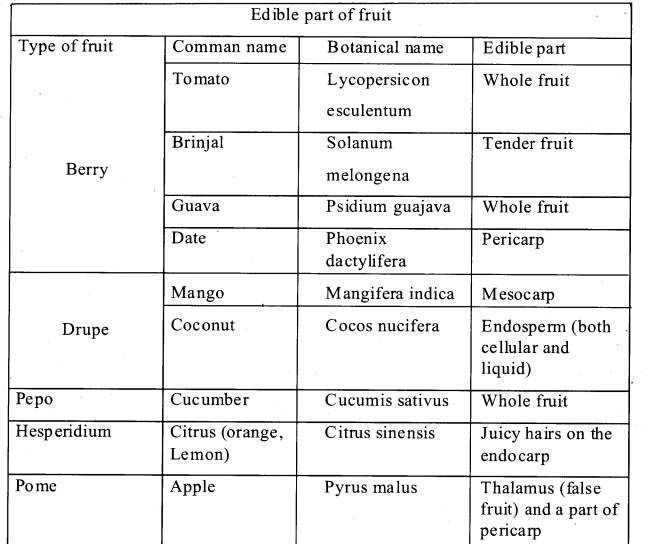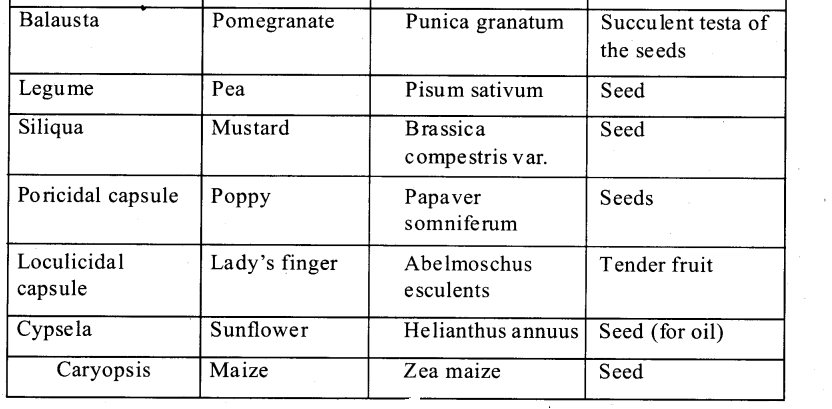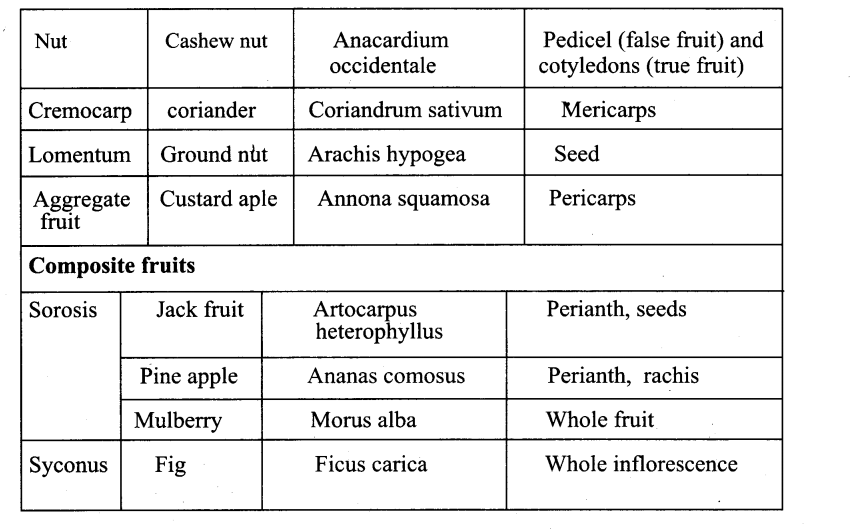Tamilnadu State Board New Syllabus Samacheer Kalvi 11th Bio Botany Guide Pdf Chapter 4 Reproductive Morphology Text Book Back Questions and Answers, Notes
Tamilnadu Samacheer Kalvi 11th Bio Botany Solutions Chapter 4 Reproductive Morphology
11th Bio Botany Guide Reproductive Morphology Text Book Back Questions and Answers
Part – I
Choose the Right Answer:
Question 1.
Vexillary aestivation is characteristic of the family
a. Fabaceae
b. Asteraceae
c. Solanaceae
d. Brassieaceae
Answer:
a. Fabaceae
Question 2.
Gynoecium with united carpels is termed as
a. Apocarpous
b. Multicarpellary
c. Syncarpous
d. None of the above
Answer:
c. Syncarpous
![]()
Question 3.
Aggregate fruit develops from
a. Multicarpellary apocarpous ovary
b. Multicarpellary syncarpous ovary
c. Multicarpellary ovary
d. Whole Inflorescence
Answer:
a. multicarpellary apocarpous ovary
Question 4.
In an inflorescence where flowers are borne laterally in an aeropetal succession, the position of the youngest floral bud shall be
a. Proximal
b. distal
c. Intercalary
d. Anywhere
Answer:
a. Proximal
![]()
Question 5.
A true fruit is the one where
a. only ovary of the flower develops into fruit.
b. ovary and caly x of the flower develops into fruit.
c. ovary, caly x, and thalamus of the flower develops into fruit.
d. All floral whorls of the flower develops is to fruit.
Answer:
a.only ovary of the flower develops into the fruit
Question 6.
Find out the floral formula for a besexual flower with bract, regular, pentamerous, distinct caly x and corolla , superior ovary without bracteole.
Answer:
![]()
Question 7.
Giving the technical terms for the following.
a. A sterile stamen …………………..
b. Stamens are united in one bunch …………….
c. Stamens attached to the petals ……………….
Answer:
a. staminode
b. monodelphous
c. Epipetalous (petalostemonous)
![]()
Question 8.
Explain different types of placentation with example
Answer:
Marginal:

It is with the plaentae along the marging of a unicarpellate ovary.
Example-Fabaceae.
Axile:
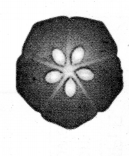
The placentae arises from the column in a compound ovary with septa.
Example-Hibiscus, tomato lemon
Superficial:
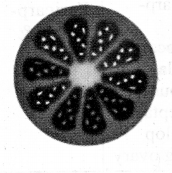
Ovules arise from the surfae of the septa.
Example: Nymphaeceae
Parietal:
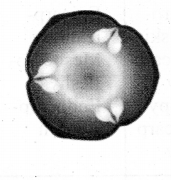
It is the placentae on the ovary walls or upon intruding partitions of a unilocular, compound Ovary.
Example: Mustard, Argemone, cucumber.
Free-central:
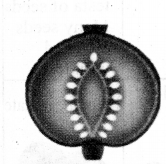
It is with the placentae along the column in a compound ovary without septa.
Example: Caryophyllaceae, Dianthus, Primrose
Basal:
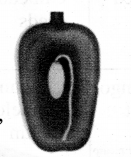
It is the placenta at the base of the ovary.
Example: Sunflower (asrteraceae) Marigold.
![]()
Question 9.
Differences between aggregate fruit with multiple fruit.
Answer:
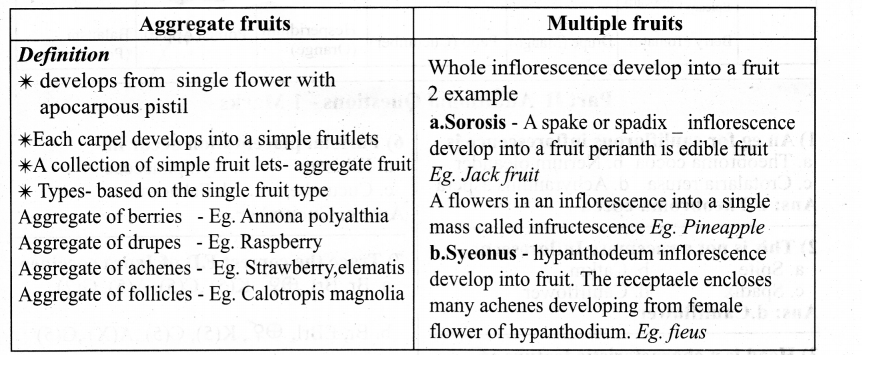
Question 10.
Explain different type of fleshy fruit with suitable example
Answer:

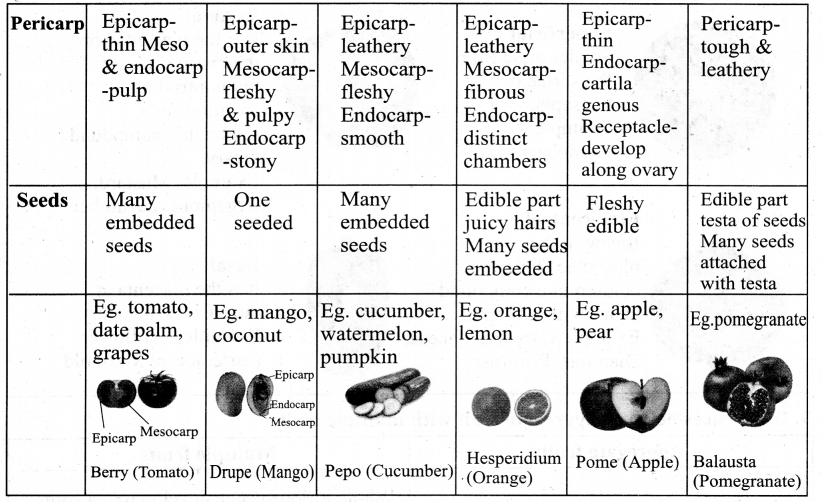
Part II
11th Bio Botany Guide Reproductive Morphology Additional Important Questions and Answers
Choose the Right Answer:
Question 1.
Placentation in tomato and lemon is …………….
(a) parietal
(b) marginal
(c) free – central
(d) axile
Answer:
(d) axile
Question 2.
This is not a racemose Inflorescence
a. Spite
b. Catkin
c. Spadix
d. Cauliflower
Answer:
d.Cauliflower
![]()
Question 3.
Geocarpic fruits are seen in …………… .
(a) carrot
(b) groundnut
(c) radish
(d) turnip
Answer:
(b) groundnut
Question 4.
Pendulose spikes occur in
a. Piper nigrum
b. Dry za sativa
c. Tridax sp
d. Zeamays
Answer:
a. Piper nigrum
![]()
Question 5.
When the calyx is coloured and showy, it is called …………… .
(a) petaloid
(b) sepaloid
(c) bract
(d) spathe
Answer:
(a) petaloid
Question 6.
Parietal placentation occurs in
a. Hibiscus
b. Nymphaeaceae
c. Cucumber
d. Fabaceae
Answer:
c. Cucumber
![]()
Question 7.
Trace the correct F.D of Jxora coccinea
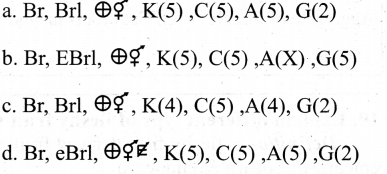
Answer:
![]()
Question 8.
In Theobroma cocoa, the inflorescence arise from …………… .
(a) terminal shoot
(b) axillary part
(c) trunk of plant
(d) leaf node
Answer:
(c) trunk of plant
![]()
Question 9.
An example for a Pseudo fruit
a. Apple
b. Tomato
c. Pumpkin
d. Mango
Answer:
a. Apple
Question 10.
The fruit type intermediate between dehiscent and indehiscent is known as
a. Regma
b. Samara
c. Schizocarpic
d. Nut
Answer:
c. Schizocarpic
![]()
Question 11.
Thyrsus is a type of …………… inflorescence.
(a) raceme
(b) cyme
(c) mixed
(d) special
Answer:
(c) mixed
Question 12.
Br, Ebrl, O7 p3+3 A(3) Go – is
a. This F.D of male flower of musa
b. The F.D of crotalaria juncea
c. The F.D. of male flower of phyllanthus amaras
d. The F.D of male flower of cocos nucifera
Answer:
c.The F.D of male flower of phyllnthus amaras.
![]()
Question 13.
Calyz is distinctly leaf-like, large often orange or white coloured as in mussenda it is known as
a. Campanulate sepals
b. Tubular sepals
c. Petaloid sepals
d. Sepaloid petals
Answer:
c. Petaloid sepals
Question 14.
If unisexual and bisexual flowers are seen in same plant then the plant is said to be …………… .
(a) polyphyllous
(b) polygamous
(c) hermaphroditic
(d) dioecious
Answer:
(b) polygamous
III. Match the following
Question 1.
(I) Spathe – A) Hibiscus sp
(II) Spikelet – B) Musa sp
(III) Epicaly – C) Paddy
(IV) Pislillate flower – D) Cocas Nucifera
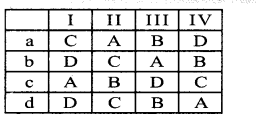
Answer:
b. D-C-A-B
![]()
Question 2.
(I) Epipetalous – A) G(2)
(II) Monoadeiphous – B) P(5)
(III) Inferior Ovary – C) A(a)
(IV) Gamophyllous – D) C(5)A5
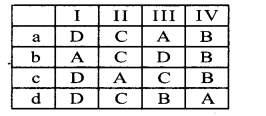
Answer:
a. D-C-A-B
Question 3.
(I) Catkin – A) Cauliflower
(Il) Corymb – B) Mangifera indica
(III) Panicle – C) Coriandrumsatiuum
(IV) Umbel – C) Coriandrumsatiuum
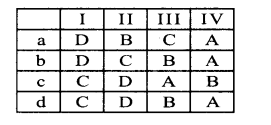
Answer:
b. D-C-B-A
![]()
Question 4.
(I) A single female flower surrounded by a group of male – A) Coenanthum flowers-enclosed in an involucre
(II) Circular disclike fleshy open receptacle bearing – B) Hypanthodium pistillate at the centre & staminate flowers at periphery}
(III) Receptacle hollow male flowers towards ostiole female – C) Polychasialcyme and neutral in the middle
(IV) Central axis ends in a flower lateral axis branches repeatedly – D) cyathium
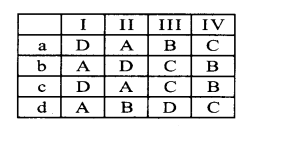
Answer:
b. D-A-B-C
Question 5.
(I) Persistent calyx – A) Calyx falls after the opening of a flower
(II) Deciduous calyx – B) Continue to grow with fruit and encloses it completely or partially
(III) Caduceus calyx – C) Calyx continues to be along with fruit forms a cup
(VI) Accresent calyx – D) Calyx falls during the early development stage of the flower
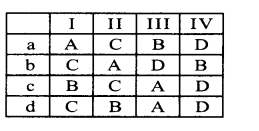
Answer:
C. C-A-D-B
![]()
IV. Choose the wrong pair
Question 1.
a. Follicle – Calotropis
b. Silicula – Capsella
c. Loculicidal capsule – Lady’s finger
d. Legume – Castor castor
Answer:
d. Legume
Question 2.
a. Raceme – Crotalaria
b. Cyme – Cyathium
c. Special type – Hypanthodium
d. Mixed type – Thyssus
Answer:
b. Cyme – Cyathium
![]()
Question 3.
a. Monoecious – Coconut
b. Dioecious – Musa
c. Polygamous – Mangifera
d. Bisexual – Brinjal
Answer:
b. Dioecius- Musa
V. Fill up the tabulation with the right answer.
Question 1.
| Condition | Explanation | Example |
| 1. Apostemonous | __________________ | Cassia |
| 2. Polyadelphons | Filaments connate into many bundles | __________________ |
| 3. __________________ | Stamens adnate to petals | Datura |
| Syngenesious | __________________ | Asteraceae |
Answer:
1. Stamens distinct do not fuse with other parts
2. Citrus
3. Epipetalous
4. Anthers connate, filaments free
![]()
Question 2.
| Attachment of Anther | Description | Example |
| 1. Basiifixed | …………………. | Datura |
| 2. …………………. | The apex of filament is attached to the dorsal side of the anther | Hibiscus |
| 3. Versatile | The filament is attached to the anther at the midpoint | …………….. |
| 4. ………….. | The filament is continued from the base to the apex | Ranunculus |
Answer:
1. Base of another is attached to the tip of the filament
2. Dorsifixed
3. Grasses
4. Adnate
VI. Choose the wrong pair
Question 1.
1. Ripened ovary – Seed
2. Ovary wall – Testa & tegmen
3. Ferlised ovule – Seed
4. Integuments of – Pericarp ovule
Answer:
3. Ferlized ovule – Seed
Question 2.
1. Cremocarp – groundnut
2. Carcerulus – coriander
3. Lomentum – abutilon
4. Regma – castor
Answer:
4. Regma – castor
![]()
Question 3.
1. Caryopsis – paddy
2. Cypsela – coriander
3. Cremocarp – groundut
4. Lomentum – sunflower
Answer:
1. Caryopsis – paddy
VII. Identify the diagram & Label it correctly
Question 1.
Cymose inflorescen or simple dichasium
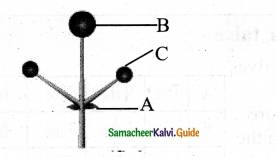
Answer:
Cymose inflorescen or simple dichasium

A-Bract
B-Old flower
C-Young flower
Question 2.
This is Papilionaceous Corolla
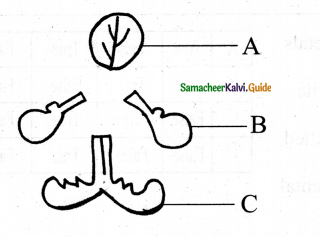
Answer:
This is Papilionaceous Corolla

A-Standard petal or corolla
B-Wing petals or alae
C-Keel petals or camia
![]()
Question 3.
The given diagram is spadix inflorescence
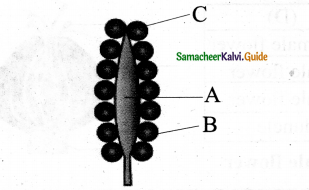
Answer:
The given diagram is spadix inflorescene

A-Central axis
B- Female flower
C- Male flower
Question 4.
The given diagram is verticillaster
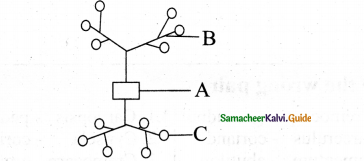
Answer:
The given diagram is verticillaster

A-Central axis
B-Monocharial scorpioid lateral branches
C-Blder flowers
![]()
Question 5.
The diagram represents the tetradynamous condition of stamen
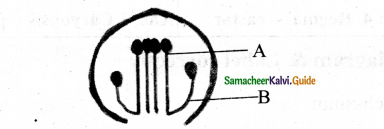
Answer:
The diagram represents the tetradynamous condition of stamen

A-4 long stamens
B-2 long stamens
VIII. Find out the true or false
Question 1.
(i) Asymmetric flowers cannot be divided into equal halves in any plane
(ii) The calyx of tridax is modified into a tubular structure
(iii) Heterostemonous stamens, have different lengths in the same flower
(iv) Hypanthium is a fleshy elevated stamina disk which is nectariferous in nature.
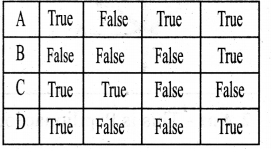
Answer:
a. True – False – True – True
Question 2.
(i) Aeswation is the arrangement of sepals and petals in the flower when it open
(ii) Lodicule is the reduced scale-like perianth in the members of Poaceae
(iii) The walls of the ovary and septa form a cavity called locule
(iv) The branch that bears the flower is called the parental axis.
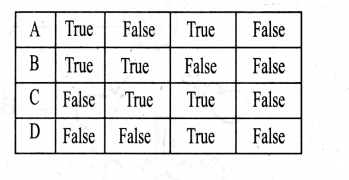
Answer:
c. False – True – True – False
![]()
IX. In the following diagram what are the parts.
Question 1.

Answer:
c. Peduncle – Involucre – Female flower – Male flower
X. Write down the edible parts of the following.
Question 1.
- Apple …….?
- Coconut …….?
- Jack fruit ……?
- Mango ……?
- Tomato ……?
- Orange …….?
- Pomegranate ……..?
Answer:
- Thalamus
- Oily endosperm
- Perianth
- Fleshy juicy mesocarp
- Epi, meso, and endocarp i.e (pericarp)
- Juicy hairs
- Testa of seed
![]()
XI. Read the following Assertion and Reason & Find the correct answer.
Question 1.
Assertion (A): Fruits are the products of pollination and fertilization
Reason (R): All floral whorls of a flower develop into a fruit
(a) A and R are correct. R is explaining A
(b) A and R are correct but R is not explaining Assertion
(c) A is true but R is wrong
(d) A is true but R is not explaining Assertion
Answer:
(c) A is true but R is wrong
Question 2.
Assertion (A): Homochlamydeous condition is prevalent in monocot
Reason (R) : Undifferentiated calyx and corolla is known as perianth
(a) A and R are correct and R is explaining A
(b) A and R are correct but R is not explaining Assertion
(c) A is true but R is wrong
(d) A is true but R is not explaining Assertion
Answer:
(a) A and R are correct and R is explaining A
![]()
Question 3.
Assertion (A): Almost all flowers are hermaphrodite
Reason (R): Male and female sex organs do not occur in the same flower
(a) A and R are correct R is explaining A
(b) A and R are correct but R is not explaining assertion
(c) A is true but R is wrong
(d) A is true but R is not explaining assertion
Answer:
(c) A is true but R is wrong
XII. Fill up the blanks by giving technical terms for the following.
Question 1.
a) The study of fruits …….
Answer:
Pomology
b) lkebana is an act of ……….
Answer:
Flower arrangement
c) The botanical name of Saffron flower ……………
Answer:
Crocus Sativum
d) The flower grows once in 12 years …………
Answer:
Kurinji (Strobilanthus kunthranus)
e) World’s largest fruit is …………………
Answer:
Lodoicea maldivica
f) King Herod’s palace, near dead sea, scientist have got a seed viable for …………. years
Answer:
20,000 years
g) The longest and largest inflorescence of any flowering plant is ………………
Answer:
Corypha umbraculifera (cudai palm)
h) The largest single flower is known sofae is ………………
Answer:
Rafflesia arnoldi
![]()
Give very short answers – 2 Marks
Question 1.
How will you define inflorescence?
Answer:
An inflorescence is a group of flowers arising from a branched or unbranched axis with a definite pattern.
Question 2.
Distinguish between Bract and Bracteole.
Answer:
|
Bract |
Bracteole |
|
|
Question 3.
Distinguish between the Posterior and Anterior sides of a flower.
Answer:
|
Posterior side |
Anterior side |
| The side of the flower facing the mother axis is called the Posterior side. It is also known the part towards the plan |
The side of the flower facing away from the mother axis is called the anterior side. It is the part away from the plant. |
Question 4.
Distinguish between Superior and Inferior Ovary.
Answer:
|
Superior Ovary |
Inferior Ovary |
| It is the attachment of ovary relative to other floral parts – if the ovary with sepals, petals and stamens attached at the base of the ovary, e.g Hibiscus, Mangifera | If in the ovary the sepals petals and stamens attached at the base of the ovary it is called Inferior. e.g Ixora or Musa. |
![]()
Question 5.
What is a sessile flower?
Answer:
A flower without a pedicel or stalk is said to be a sessile flower.
Question 6.
What is the use of Pappus?
Answer:
Pappus is the hair-like structures – (modification of calyx)
Pappus occur in Asteraceaemembers – They help in the dispersal of fruits.
Question 7.
Write the units of (a) Perianth and (b) Calyx.
Answer:
The units of (a) Perianth and (b) Calyx:
- Perianth – tepals and
- Calyx – sepals
Question 8.
Distinguish between Apocarpous & Syncarpous.
Answer:
|
Apocarpous |
Syncarpous |
| A pistil containing two or more distinct carpels is known as apocarpous condition e.g Annona | A pistil containing two or more carpels which write or cannot-it is known as a syncarpous condition, e.g citus, tomato |
Question 9.
Define a Carpel & Locule.
Answer:
|
Carpel |
Locule |
| Components of gynoecium usually made of one or more carples they may be distinct or cannot Usually no. of carpel equals the no.of locule | The walls of the ovary and (crosswall of ovary from a cavity called lcoule Usually no.of locules equals the no of carples exception Bicarpellary unilocular condition in Asteraceae |
Question 10.
Draw the structure of the Anthophore.
Answer:
Intermodal extension between Calyx and Coralla
A – Androecium
B – Gynoecium
C – Corolla
D – Anthophore
E – Calyx
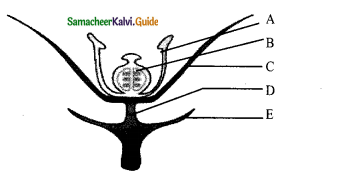
Question 11.
Classify racemose Inflorescence.
Answer:
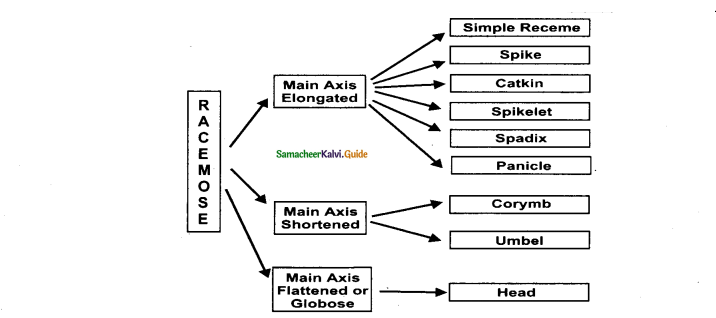
Question 12.
Draw the structure of Hypanthodium and label the parts.
Answer:
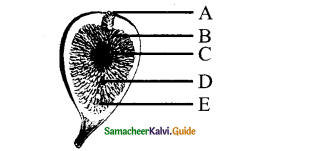
A – Ostiole
B – Male flowers
D – Neutral flower gall flower
C – Female flower
E – Receptacle
![]()
Question 13.
Compare Achene & Caryposis.
Answer:
|
Achene |
Caryopsis |
| Indehiscent one-seeded fruit Develop from monocarpellary ovary Pericarp hard leathery-remain free from seed coat E.g. Clematis | Indehiscent one-seeded fruit Develop from monocarpellary ovary Pericarp fused with seed coat E.g. Paddy |
Question 14.
Compare Legume and Follicle
Answer:
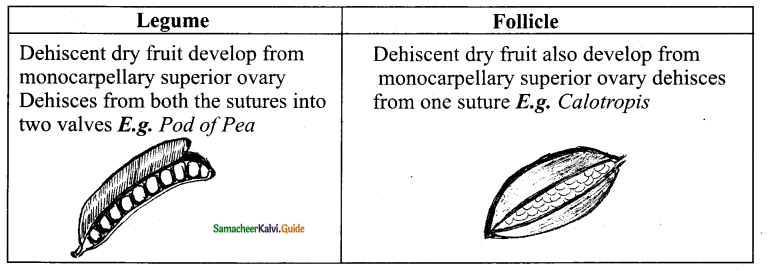
Question 15.
Differentiate between Dicotyledonous seed and Monocotyledonous seed.
Answer:
|
Dicot |
Monocot |
| Two cotyledons occur Usually cotyledons store food and become thick and fleshy nourishes seedling during early development E.g.Pea | Only one cotyledon occur The endosperm persistent and nourishes the seedling during early development E.g. Castor |
Question 16.
Differentiate between Albuminous and Non-albuminous seed.
Answer:
|
Albuminous seed |
Non Albuminous seed |
| The cotyledons are then membranous and mature seeds have endosperm persistent and nourishes the seedling during its early development. Eg. Castor, Sunflower | Food is stored in cotyledons and mature seeds are without endosperm. Eg. Pea, Groundnut |
Give Short Answers – 3 Marks
Question 1.
Differentiate between Racemose and Cymose Inflorescence.
Answer:
|
Characters |
Racemose |
Cymose |
| 1. Main axis | Unlimited growth | Limited growth |
| 2. Arrangement of flowers | Acropetal succession | Basipetal succession |
| 3. Opening | Centripetal | Centrifugal |
| 4. Oldest flower | At the base | At the top |
Question 2.
What is meant by Salver shaped or Hypocrateriform corolla. Give Eg.
Answer:
Petals of a flower fused to form a long narrow tube with spreading limbs are called salver-shaped or hypocrateriform corolla.
E.g. Ixora, Catharanthus sp.
![]()
Question 3.
Differentiate between Corymbose and Umbellate inflorescence by drawing diagrams.
Answer:
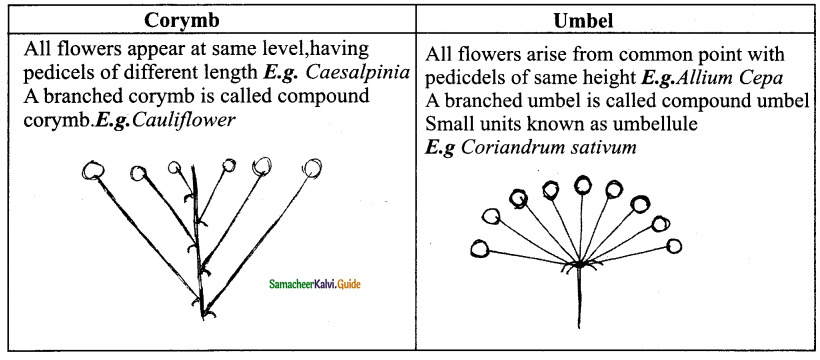
Question 4.
Why do we call Thyrsus as Raceme of Cymes?
Answer:
a. The main axis is indefinite growth like raceme
b. But it bears pedicellate cymes on either side laterally. E.g. Ocimum sanctum.
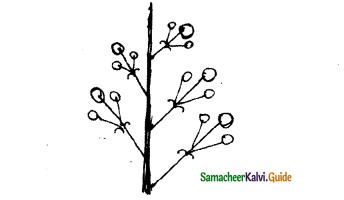
Question 5.
Differentiate between Cyathium and Coenanthium.
Answer:
|
Cyathium |
Coenanthium |
| A single female flower surrounded by many male flowers enclosed by a common involucre Flowers are naked-Aclamydeous Extrafloral nectary is present in involucre E.g. Euphorbia | Circular disc-like fleshy open receptacle bearing many pistillate or female flowers at the center surrounded by many male or staminate flowers at the periphery. Eg. Dorsenia |
Question 6.
Differentiate between Homogamous head & Heterogamous head inflorescence.
Answer:
|
Homogamous Head |
Heterogamous Head |
| Only one kind of florets 2 Types Has only tongue florets- E.g. Launaea Has only tube florets – E.g. Vernorua | It has 2 types of florets -Tongue of ray, Tube of Disc Tongue florets seen towards the periphery, and Tube florets located at the centre of the inflorescence E.g. Helianths & Tridax |
Question 7.
Distinguish between the two types of Monochasial Cyme.
Answer:
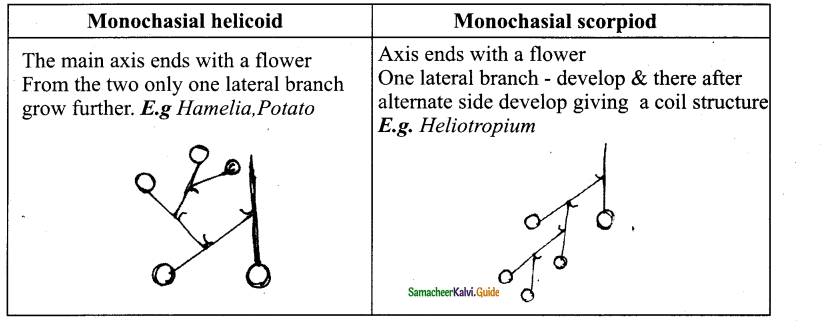
Question 8.
Distinguish between Anthophore and Androphore, Gynophore and Gynandrophore
Answer:
|
Anthophore |
Androphore | Gynophore |
Gynandrophore |
| The intermodal elongation between calyx and corolla E.g. Silene conoidea | The internal elongation between coralla and Aroecium E.g. Grewia | The internal elongation between Androecium and cynoecium E.g. Capparis | The unified internal elongation between corolla and Androecium as well as between Androecium and gynoecium E.g gynandropsis |
Question 9.
Distinguish between Connation & Adnation
Answer:
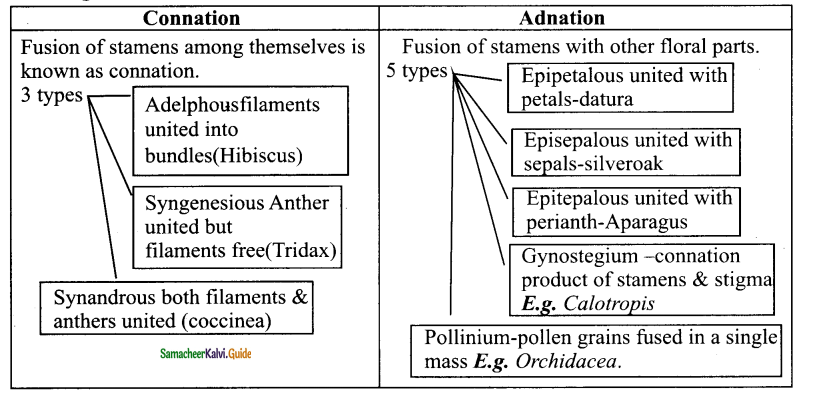
Question 10.
Differentiate between Didynamous and Tetradynamous condition of the stamen.
Answer:
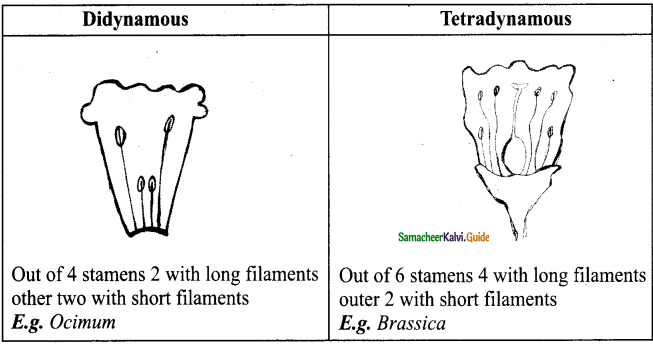
Question 11.
Explain the various types of Schizocarpic fruit.
Answer:
This fruit type of intermediate between dehiscent and indehiscent fruit. The fruit instead of dehiscing rather splits into a number of segments, each containing one or more seeds. They are of the following types:
- Cremocarp: Fruit develops from bicarpellary, syncarpous, inferior ovary and splitting into two one-seeded segments known as mericarps. e.g., Coriander and Carrot.
- Carcerulus: Fruit develops from bicarpellary, syncarpous, superior ovary and splitting into four one-seeded segments known as nutlets, e.g., Leucas, Ocimum and Abutilon.
- Lomentum: The fruit is derived from monocarpellary, unilocular ovary. A leguminous fruit, constricted between the seeds to form a number of one seeded compartments that separate at maturity, e.g., Desmodium, Arachis and Mimosa.
- Regma: They develop from tricarpellary, syncarpous, superior, trilocular ovary and splits into one-seeded cocci which remain attached to carpophore, e.g., Ricinus and Geranium.
Question 12.
Identify the plant & Write down the floral formula of the given floral diagram.
Answer:

Question 13.
Draw the floral diagram of Ixora Coccinea flower and write down floral formula.
Answer:
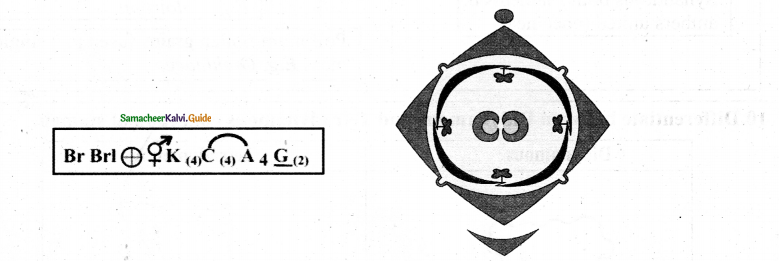
Question 14.
Classify the anthers based on their mode of attachment.
Answer:
The anthers based on their mode of attachment:
- Basifixed: (Innate) Base of anther is attached to the tip of filament, e.g., Brassica, Datura
- Dorsifixed: Apex of filament is attached to the dorsal side of the anther, e.g. Citrus, Hibiscus
- Versatile: Filament is attached to the anther at midpoint, e.g., Grasses
- Adnate: Filament is continued from the base to the apex of anther, e.g. Verbena, Ranunculus, Nelumbo.
Essay Questions – 5 Marks
Question 1.
Distinguish between Monoecious – Dioecious &Polygamous.
Answer:
| Monoecious | Dioecious | Polygamous |
| a.One house i.e male and female flowers present in the same flower . E.g. Coconut | Two house i.e male and and female flowers present on separate plants E.g. Papaya |
Here male flowers(staminate) female flowers (pistillate) & bisexual flowers occur in a single plant E.g. Mangifera |
Question 2.
List out the significance of fruits.
Answer:
The significance of fruits:
- Edible part of the fruit is a source of food, energy for animals.
- They are source of many chemicals like sugar, pectin, organic acids, vitamins and minerals.
- The fruit protects the seeds from unfavourable climatic conditions and animals.
- Both fleshy and dry fruits help in the dispersal of seeds to distant places.
- In certain cases, fruit may provide nutrition to the developing seedling.
- Fruits provide source of medicine to humans.
Question 3.
What are the various parts of a typical flower.
Answer:
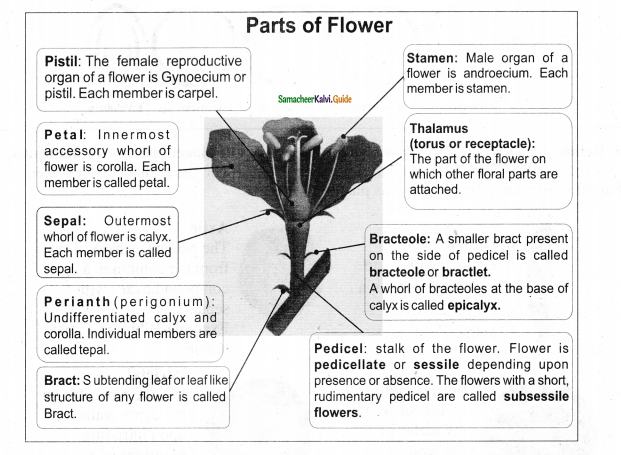
Question 4.
Detìne Aestivation Give an account of various types of aestivation?
Answer:
- Aestivation: Arrangement of sepals and petals in the flowers bud.
- Types : There are 5 types
- Valvate : Margins of sepals and petals do not overlap but touch each other.
Eg. Calyx — malvaceac inem bers . - Twisted or convolute or contorted: One margin of each petal or sepal overlapping on
the other petal – Eg. Corolla of Malvaceae (china i-ose) - Imbricate : Sepals\ Petalsepals petaals – overlap irregularly one member of the whorl-
exterior another interior other three one margin exterior other interior
3 types
- Ascending-imbricate Eg. Cassia,
- . Descendingly-imbricate (vexillary aestivation) Eg. Clihoria,
- . Quincuncial- Eg. Guava
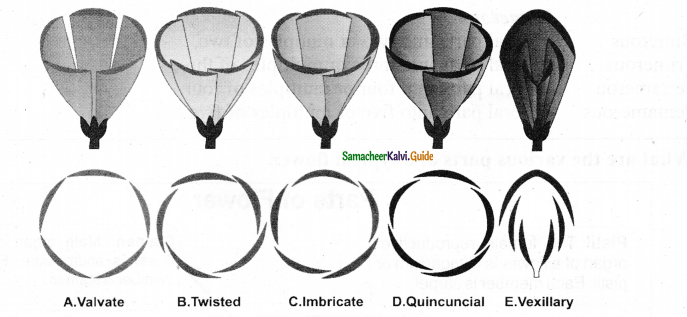
Question 5.
Define placentation and explain the various types of placentation with diagrams.
Answer:
Marginal:

It is with the plaentae along the marging of a unicarpellate ovary.
Example-Fabaceae.
Axile:

The placentae arises from the column in a compound ovary with septa.
Example-Hibiscus, tomato lemon
Superficial:

Ovules arise from the surfae of the septa.
Example: Nymphaeceae
Parietal:

It is the placentae on the ovary walls or upon intruding partitions of a unilocular, compound Ovary.
Example: Mustard, Argemone, cucumber.
Free-central:

It is with the placentae along the column in a compound ovary without septa.
Example: Caryophyllaceae, Dianthus, Primrose
Basal:

It is the placenta at the base of the ovary.
Example: Sunflower (Asteraceae) Marigold.
Question 6.
Draw the floral diagram and flower of Cocos Nucifera and try to describe the flower with the floral diagram and floral formula.
Answer:
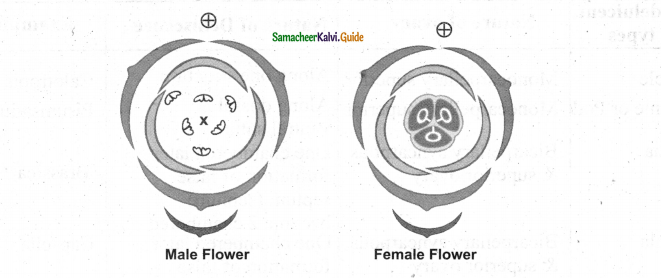
Male flower // Femle flower
Male flower of Cocos nucifera.
Male flower – Unisexual male Actinomorphic Bracteate, Bracteolate Incomplete
Perianth – 6 tepals – outer 3 and inner 3 two whorlsimbricate – apophyllous
Androecium – 6 stamens – outer 3 and inner 3 – free anther dithecous
Gynoecium – Absent – pistillode present
Female Flower – Unisexual female Actinomorphic Bracteole, ebracteolate, incomplete
Perianth – 6 tepals outer 3 -inner 3 outer valvate, inner imbricate apophyllous
Androecium – Absent staminode tricarpellary
Gynoecium – Ovary superior – tricarpellary trilocular syncarpous- ovules-Axile Placentation.
Question 7.
Describe the ovary types on the basis of its positive relative to other parts.
Answer:
The ovary can be divided into 3 types on this basis
Superior Ovary : (Flower Hypogynous)
It is the ovary with sepals, petals and stamens attached at the base of the ovary.
In feriror ovary : (Flower Epigynous)
It is the ovary with sepals, petals and stamens attached at the apex of the ovary.
Half inferior ovary : (Flower Perigynous) It is the ovary with sepals petals and stamens or hypanthium attached near the middle of the ovary

Question 8.
Give an account of Dry Dehiscent fruits.
Answer:
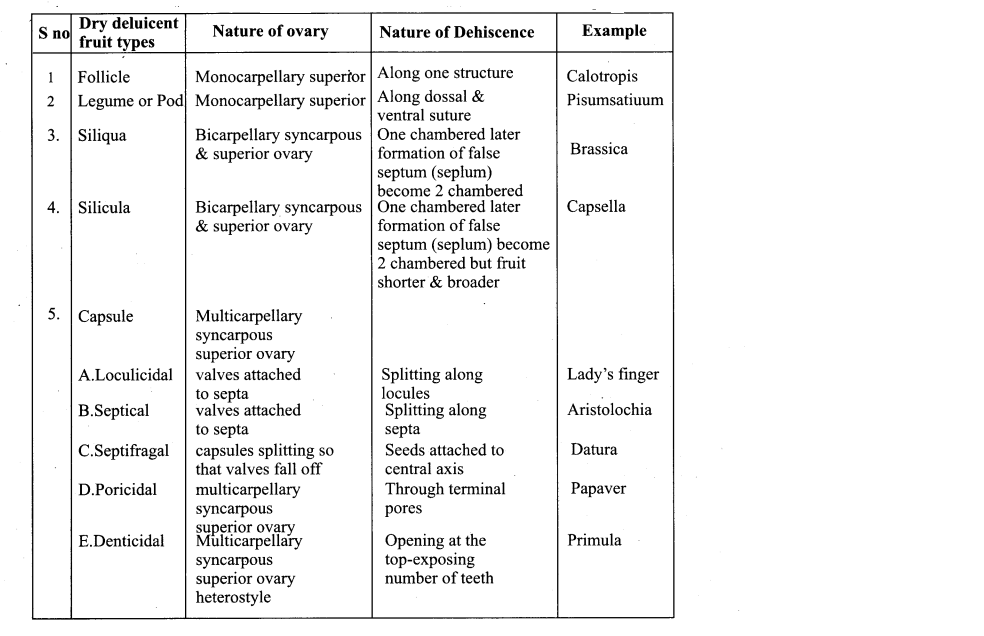
Question 9.
Give an account of dry indehiscent fruits.
Answer:
| Type of fruit | Nature of ovary | Special aspects | Example | |
| 1. | Achene | Monocarpellary superior ovary Apocarpous | Apocarpous Fruit wall pericarp is free from seed coat. | Clematis strawberry |
| 2. | Cypsela | Bicarpellary inferior ovary syncarpous | Reduced scales Hairy or feathery – calyx lobes-Pappus | Tridax helianthus |
| 3. | Caryopsis | Monocarpellary superior ovary | Fruit wall inseparably fused with seed | Oryza triticum |
| 4. | Nut | Multicarpellary syncarpous superior ovary | Hard woody bony pericarp | Anacardium |
| 5. | Samara | Monocarpellary superior ovary | Pericarp (ovary wall) Develop into then wing-like structure – help in fruit dispersal | Pterocarpus |
| 6. | Utricle | Bicarpellary unilocular syncarpous superior ovary | Pericarp loosely encloses the seed. | Chenopodium. |
Question 10.
Explain only the racemose type with the elongated main axis.
Answer:
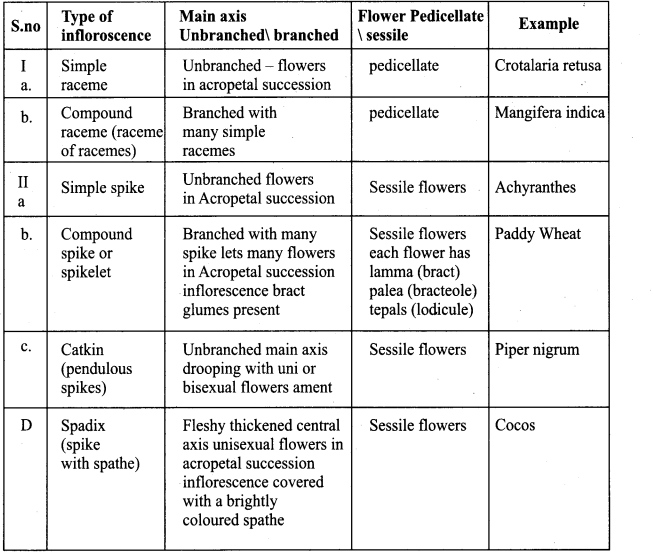
Question 11.
Draw a chart depicting various types of Fruits.
Answer:
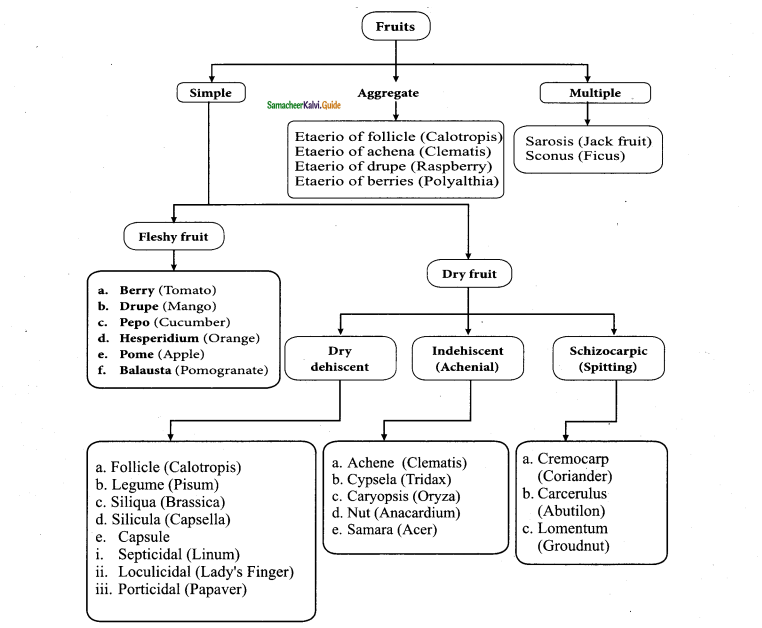
Question 12.
What is the significance of Seeds?
Answer:
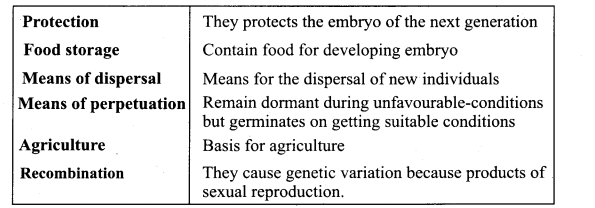
Question 13.
Draw the tabulation showing various fruits & their edible part.
Answer:
